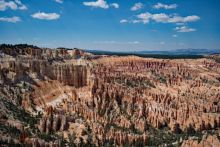Geoscience Currents transmit snapshots of the many facets of the geoscience profession, in-depth case studies of how geoscience is applied, factsheets that provide rigorous introductions to a range of geoscience topics, workforce trends, and career paths.
Partner with us to help support well-informed public policy and decision making with expert, impartial geoscience information. Visit our Sponsorships page for more information or email sponsorships@americangeosciences.org.
Displaying 171 - 180 of a total of 225 items

November 01, 2011
Attendance at U.S. field camps reached 2,525 in 2011, up 10 percent from 2010. Field camp attendance for 2011 was reported by 94 of the existing 118 U.S. field camps. (Some field camps run on alternating years). Recent increases in field camp attendance are attributed to both increased overall...

October 28, 2011
AGI’s GeoConnection Recruitment Packets provide geoscience departments with a tool to directly engage prospective geoscience majors in a discussion about the many career opportunities in the geosciences, and about the importance of participation in geoscience professional societies and conferences...

September 30, 2011
Employment in geoscience-related occupations is expected to grow about 23 percent between 2008 and 2018, which is much faster than the average growth of all U.S. occupations (10%). Environmental engineers are expected to see the largest growth in number of new jobs with a 31 percent growth rate,...

September 26, 2011
Over the past year, aggregate employment in geoscience-related occupations has remained relatively steady. A few occupations (environmental engineers, mining and geological engineers, environmental scientists, geoscientists, and hydrologists) have seen a slight contraction in occupational...

September 19, 2011
In 2010, average aggregated salaries for geoscience-related occupations ranged from $137,660 for geoscience-related occupations in the finance and insurance industry to $69,949 for geoscience-related occupations in state government. Salary ranges for the aggregated occupations were as narrow as $26...

September 14, 2011
Salaries for chemists, physicists and biological/life scientists primarily fall within the range of salaries for geoscience-related occupations. Over the past decade, however, salaries for geoscience-related occupations have grown as fast or faster than salaries for these other science occupations...

September 07, 2011
Despite the lagging U.S. economy, salaries for aggregated geoscience-related occupations increased by 1.1 percent between 2009 and 2010. Aggregated salaries for all life, physical and social science occupations decreased by 0.9 percent while salaries for all U.S. occupations only increased by 0.2...

August 09, 2011
Houlton’s pathway model (2010) established a theoretical framework for identifying reasons for attraction to and attrition from the geoscience major. Houlton used Academic Provenance Analysis to map geoscience students’ experiences temporally; it described the linear progression from students’...

July 26, 2011
Houlton (2010) found that three geoscience student populations followed six distinct pathway steps in pursuing their career in the discipline (see Geoscience Currents #45-46). Within the students’ pathways, two steps specically identify Pre-College and College Critical Incidents: specic events,...

July 12, 2011
Houlton (2010) found that geoscience students followed 6 distinct pathway steps in pursuing their career in the discipline (see Geoscience Currents #45). Further investigation illuminated that students could be categorized into 3 major and 6 minor population groups, each exhibiting a unique pathway...
Pages
Upcoming Webinars

